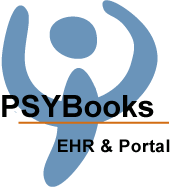Video Tutorials
Quick Vids (A variety of topics each under 3 minutes)
-
File Storage in PSYBooks (Duration: 2:31)
File storage in PSYBooks is easy, HIPAA-compliant and developed with therapists in mind. Store client records in their charts and your own files in the therapist section – there are separate places for each.
-
How to Efile (Duration: 0:49)
Efiling is as simple as adding a session. In most situations, it only requires 3 clicks. (There's a more detailed version of How to Efile below.)
-
Managing Client Files: Digital vs Paper (Duration: 1:55)
Digital charts have the same features as paper charts but they're easier to manage and you can do more with them. This video shows how PSYBooks charts are organized and how easy it is to maintain, archive and delete digital client records.
-
Preparing to Efile (Duration: 1:42)
Preparing to efile is just a matter of adding the insurance information to the client's chart. This video will show you how. (There's a more detailed version of Preparing to Efile below.)
Filing Insurance
-
Add a Client (Duration: 1:54)
Forms in PSYBooks are designed to have the fewest number of required items possible so you're not wasting time filling in fields you don't really need. The Add Client form is a great example: you can create an entire client chart with just the client's name and birthday.
-
Prepare to Efile (Duration: 6:42) There's a shorter version of Preparing to Efile in the Quick Vid section above.
There's a one-time setup to get a client's chart ready to efile. All you have to do is choose the client's insurance company from the list in PSYBooks, enter the client's ID and attach it to their chart. After that step is done, every time you add a session for that client, you'll be able to efile the claim by just saving the session. This video walks you through the steps.
-
How to Efile (Duration: 1:59) There's a shorter version of How to Efile in the Quick Vid section above.
Once a client's file has been prepared to efile (see the Prepare to Efile video above), there are only three steps to actually efile a claim:
- Add a session
- Save the session
- Process the session
When these steps are complete, the claim will be on its way to the insurance company and PSYBooks will give you a link to a PDF of the CMS-1500 form of the claim.
PSYBooks remembers your previous Add Session form for each client which means that often, there's nothing for you to do when you open the Add Session form except click Save. Because of this, efiling often just requires 3 clicks (and no typing): one click to open the Add Session form, a second click to save the session and a third to process it. This video lets you watch it in action.
-
Paper Claims (Duration: 5:17)
When you don't want to efile, PSYBooks can create paper insurance claims for you that you can print, fax or upload. The steps are the same as for efiling except that you attach a 'paper' insurance company to your client's chart instead of an efile company. As with efiling, once the insurance is attached to the chart, creating a paper claim will likely only require 3 clicks.
Client Statements
-
Introduction to Client Statements (Duration: 1:05)
Therapists differ in how, or if, they use client statements. Some like to hand the client a statement at the end of each session. Others prefer to wait until insurance payments are posted so they can bill the remaining balance to the client. Others send statements weekly or monthly, and still others don't use statements much at all because they run "pay as you go" types of practices.
-
Client Statements when Adding a Session (the 'Add Session' Statement) (Duration: 2:33)
You can create a statement for private pay clients after each session. This video shows you how.
-
Client Statements after Adding an Insurance Payment (the 'Add Payment' Statement) (Duration: 6:26)
After adding an insurance payment, the balance due on the session is generally billed to the client. PSYBooks gives you the option of producing a statement each time you enter an insurance payment. You don't have to, of course. PSYBooks requires as few things as possible. But if your natural practice flow is to send statements after receiving insurance payments, PSYBooks makes it easy to do.
-
Client Statements from the Sessions & Payments tab (the 'Sessions & Payments' Statement) (Duration: 7:00)
This type of statement allows you to customize the statement's template to include only the items you need. You can also set a date range to include the exact set of sessions you want on the statement.
-
Client Statements Created in the Reports Section (the 'Reports' Statement) (Duration: 3:01)
This type of statement allows you to produce statements for all of your clients at once. It's ideal for sending weekly or monthly statements to your entire practice. You can also choose individual clients if you want. The Reports Statement has more flexibility and options than any of the other statement types.
Entering Payments
-
ERAs (Electronic EOBs) (Duration: 11:17)
Once you sign up for ERAs, PSYBooks gets them automatically 24/7. When you receive one, there's a one-click ERA feature that enters the pertinent information from the ERA into the client's chart and recalculates their balances accordingly. It's amazingly easy! No more trying to figure out how to understand and enter the information from a paper EOB.

